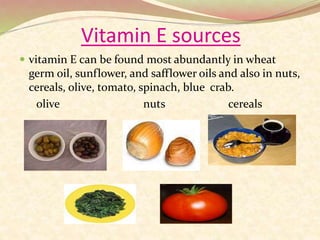QUANTITATIVE DETERMINATION OF VITAMIN A AND VITAMIN E
- 1. QUANTITATIVE DETERMINATION OF VITAMIN A AND VITAMIN E
- 2. VITAMINS ? Vitamins are naturally occurring organic compounds that are essential to metabolic or other functions in the body. ? Most vitamins cannot be synthesized by the body. They must be supplied in the diet. ? Vitamins are usually classified as water soluble or fat soluble
- 3. CLASSIFICATION OF VITAMINS ? Vitamins can be classified as either ? Water soluble ? Fat soluble. ? Water soluble vitamins are generally involved in the cellular metabolism of energy supplying nutrients. ? Fat soluble vitamins often have very specialized functions
- 4. Water Soluble Vitamins ? Examples of water soluble vitamins Vitamin C Vitamin B1 (Thiamine)
- 5. Fat Soluble Vitamins ? Common fat soluble vitamins include ? A, ? D, vitamin A ? E, ? K.
- 6. Vitamin A Sources ? Commonly found in cod liver oil, green vegetables, and fruits. ? Carrots indirectly serve as a source of vitamin A since they contain ¦Â carotene which the body readily converts to vitamin A
- 7. Vitamin A Functions ? Vitamin A is fat soluble. ? It is not readily broken down by cooking. ? Role in aiding in night vision. ? Vitamin A Deficiencies ? A deficiency in vitamin A results in night blindness. ? The most serious deficiency results in a condition known as Xeropthalmia, a severe form of conjunctivitis or blindness.
- 8. Vitamin E sources ? vitamin E can be found most abundantly in wheat germ oil, sunflower, and safflower oils and also in nuts, cereals, olive, tomato, spinach, blue crab. olive nuts cereals
- 9. Vitamin E functions ? Vitamin E is used to refer to a group of fat-soluble compounds that include both tocopherols and tocotrienols. ? ¦Á-Tocopherol is an important lipid-soluble antioxidant. ? ¦Á-Tocopherol has a regulatory effect on enzymatic activities ? responsible for the repair of the wounds and regeneration of the extracellular tissue, vitamin E also plays a role in neurological functions, and inhibition of platelet aggregation
- 10. Quantitative determination of vitamin A ? Category: antixerophthalmic vitamin ? Structure: ? Standards: not less than 95% and not more than 110% of standard number of units of vitamin A per g.
- 11. ? Identification: exhibits a maximum at about 325- 327nm. ? QUANTITATIVE ESTIMATION METHOD: ? UV-Spectrophotometric method ? principle: ? it absorbs the UV-radiation ranges from 200nm to 400nm. ? Valence electrons absorb the energy, there by molecule undergo transition from ground state to excited state. ? By the absorption peaks the nature of electrons and molecular structure can be elucidated.
- 12. ? METHOD: ? Dissolve an accurately weighed quantity of the substance in cyclohexane to give a solution containing 9 to 15 units of vit A per ml. ? Determine the wave length of maximum absorption. ? Measure the absorbance of the solution against cyclo hexane at 328 nm. ? If the wave length of maximum absorption lies between 326 and 329 calculate the vit A potency of the sample from the expression A328(A1% 1cm) ¡Á 1900 = vit A potency in units per g.
- 13. ? If the relative absorbances are not within the limits then calculate a corrected absorbance at about 328nm by applying the observed values to the equation A328(corr.) = 3.52 (2A328 ¨CA316 ¨C A 340) ? If the wavelength of maximum absorbance lies out side the range of 323 to 327 then the unsaponifiable fraction of the sample must be further purified by chromatography.
- 14. Quantitative determination of vitamin E ? Category: anti oxidant ? Structure: ? Standards: it contains not less than 96% and not more than 102% of C31H52O3.
- 15. QUANTITATIVE ESTIMATION METHOD: Chromatographic method: Principle: ? The principle of separation in GAS CHROMATOGRAPHY is partition. ? They travel according to their partition coefficients towards the stationary phase. ? More soluble travels slower ? Less soluble travels faster ? No two components have same partition coefficients. ? The components are separated according to their partition coefficients.
- 16. ? METHOD: ? Internal standard solution: dissolve an accurately weighed quantity of hexa decyl hexa decanoate in n- hexane to obtain a solution having a known concentration of about 1mg per ml. ? Standard preparation: dissolve in internal standard solution a suitable quantity of USP alpha tocopherol RS to obtain a solution having known concentration of 1mg per ml. ? Assay preparation: transfer 50mg of vitamin E to a 50ml volumetric flask, dissolve in internal standard solution, dilute with internal standard solution to volume and mix.
- 17. Chromatographic system ? The GC instrument is equipped with a flame ionization detector. ? It contains 2m-4mm borosilicate glass column packed with 2% to 5% liquid phase on 80 to 100 mesh support utilizing a column injection. ? The column is maintained at a temp. between 245¡ã to 265¡ã
- 18. ? The injection port and detector block are maintained at about 10¡ã higher than the column temperature. ? The flow rate of dry carrier gas is adjusted to obtain a peak approximately 18 to 20 min after sample introduction. ? Procedure: ? Inject a suitable portion (2-5?l) of the assay preparation into a suitable gas chromatograph. ? Record the chromatogram . ? Measure the areas under the 1st(alpha tocopherol) and 2nd major(hexadecyl hexa decanoate)peaks, record the values as aU and aD respectively. ? Calculate the quantity in mg, of vit E taken by the formula (50CD/F)(aU/ aD) Where CD is conc.in mg/ml F is the relative response factor
- 19. REFERENCES ? INDIAN PHARMACOPOEIA ? BRITISH PHARMACOPOEIA ? UNITED STATES PHARMACOPOEIA ? www.googleimages.com ? www.wikipedia.com ? www.cyberlipid.org
- 20. Size: 299 ¡Á 300 Type: 438KB GIF



















